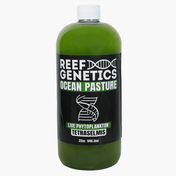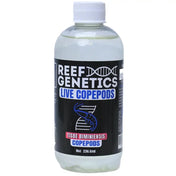Introduction to Saltwater Moray Eels
Saltwater Moray Eels are iconic, snake-like reef predators known for their elongated bodies, powerful jaws, and habit of peeking out from rock crevices with their mouths rhythmically opening and closing (a natural breathing motion). Found in coral reefs, rocky coastlines, and lagoons worldwide, morays are intelligent, hardy, and long-lived aquarium inhabitants. They thrive in aquariums that provide multiple hiding spots and secure rockwork. While generally reclusive, Moray Eels have strong feeding responses and may consume any tankmate small enough to fit in their mouth. Due to their strength, size, and escape potential, they are best kept by experienced aquarists with properly secured aquarium systems.
Care Requirements
Care Level: Moderate to Advanced – Requires secure, well-structured aquarium
Minimum Tank Size: 55 – 200+ gallons
-
Smaller species (e.g., Snowflake Moray) – 55-75+ gallons
-
Larger species (e.g., Zebra Moray, Green Moray) – 125-200+ gallons
Aquarium Setup:
Requires rock caves, tunnels, and crevices to hide in. A tight-fitting, escape-proof lid is essential, as morays are notorious escape artists. Strong biological filtration is needed because they produce heavy waste, especially when eating protein-rich foods.
Diet & Nutrition
Moray Eels are carnivores that require a meaty diet composed of marine-origin foods.
Diet: Carnivorous – Prefers fish, crustaceans, and mollusks
Recommended Foods:
-
Fresh or frozen shrimp, squid, clams, scallops
-
Chunks of marine fish (e.g., mahi, salmon pieces)
-
Silversides, krill, and other meaty seafood
Feed 2–3 times per week, rather than daily.
Avoid freshwater feeder fish (e.g., goldfish) due to poor nutritional value and risk of health issues.
Tongs should always be used when feeding to avoid accidental bites.
Lifespan & Growth Rate
Lifespan: 10–30+ years in captivity with proper care
Growth Rate: Moderate to Fast – Many species reach 1.5–4+ feet
Some species, such as the Green Moray or Tesselata Moray, can reach massive sizes and should only be housed in very large aquariums or public exhibits.
Temperament & Compatibility
Temperament: Semi-Aggressive – Predatory but usually not openly hostile
Reef Safe? Reef Safe with Caution – Safe with corals, not safe with small fish or crustaceans
Morays typically ignore larger, confident fish but will eat:
-
Small fish
-
Crabs
-
Shrimp
-
Any tankmate that fits in their mouth
Best tankmates include:
-
Larger Angelfish
-
Groupers
-
Triggers (non-nippy species)
-
Large Wrasses
Avoid housing with fish that pick at fins or exposed flesh, as this stresses the eel.
Common Challenges & Considerations
-
Escape Risk: Will exploit even the smallest gap in lids or plumbing
-
Large Waste Output: Requires strong filtration and regular water changes
-
Feeding Injuries: Use feeding tools; morays have poor eyesight but strong feeding responses
-
Size Planning: Some species quickly outgrow small aquariums
Water Conditions
-
Temperature: 72–78°F
-
dKH (Alkalinity): 8–12
-
pH: 8.1–8.4
-
Specific Gravity: 1.022–1.025
Stable parameters and high dissolved oxygen levels are essential for long-term health.
Color Varieties & Popular Species
Saltwater Moray Eels come in a variety of striking patterns and sizes.
-
Snowflake Moray (Echidna nebulosa) – Ideal beginner eel; colorful and hardy
-
Zebra Moray (Gymnomuraena zebra) – Gentle shellfish-eater with bold banding
-
Dragon Moray (Enchelycore pardalis) – Highly sought-after, dramatic coloration
-
Green Moray (Gymnothorax funebris) – Large, powerful species suitable only for very large tanks
At Top Shelf Aquatics, we take pride in ensuring your order arrives safely and in perfect condition. Here’s everything you need to know about our shipping process:
Livestock Shipping Details
- Flat Rate Shipping:
- $39.99 Out of State
- $34.99 Florida (In-State)
- Orders over $299 ship FREE!
- NO FREE Shipping during Sale Events
- Shipping Days: The calendar during checkout determines when your livestock order will arrive. Normally we ship Monday - Thursday via FedEx Priority Overnight.
Orders placed by 2 PM EST Monday - Thursday ship the same day. Orders placed after 2 PM or on Fridays will ship the next business day. - Delivery Times: Most packages arrive by 10:30 AM EST, though remote areas may experience later deliveries.
We take every measure to protect your livestock, including specialized packaging to maintain temperature and safety during transit.
Dead on Arrival (DOA) Policy
In the rare event of a DOA, you must submit a DOA Request within 2 hours of delivery (FedEx posted time). Once submitted, we will issue a replacement or store credit for the livestock. Please note:
- Shipping costs are not included in the credit.
- Refunds are not offered for livestock or shipping.
While we cannot be held responsible for delays caused by mechanical or weather issues, rest assured we’ll do everything possible to make it right!
Reef Guard Protection Plan
For ultimate peace of mind, upgrade to our Reef Guard Protection Plan. With Reef Guard, you’ll enjoy:
- Extended Livestock Guarantee: Coverage for up to 5 days.
- Priority Resolutions: Hassle-free claims with fast resolutions.
- Weather & Shipping Delay Coverage: Includes FedEx lost packages and damages.
Shipping Restrictions
- We currently ship livestock only within the continental U.S.
- Note: Due to Hawaii state law, we are unable to ship corals to Hawaii.
Now’s the perfect time to prepare your aquarium for its new additions. Consider doing a water change and ensuring space is ready. Check out our YouTube channel for detailed care instructions for your new corals!
For any questions or concerns, feel free to reach out to our support team. We’re here to help make your reefing journey a success!
5 Day Reef Guard
Temp-Control Box
Priority Overnight
Expert Care Support




















